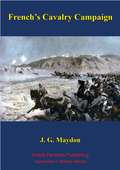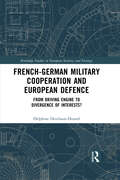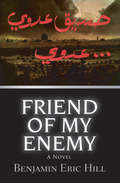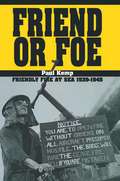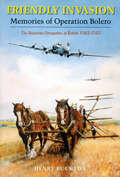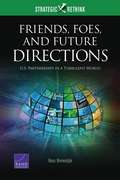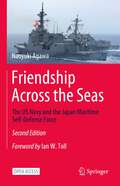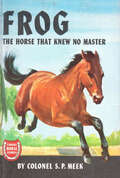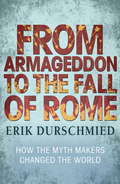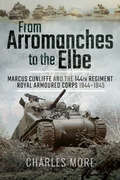- Table View
- List View
French's Cavalry Campaign
by John George MaydonField-Marshal French is best known for his military services during the First World War; however, his military service stretches back through to his commands in the Boer War. In his campaigns with the newly formed cavalry division he was to receive much acclaim and praise for his adroit handling of his troops and their effectiveness against the largely irregular Boers. He won the battle of Elanslaagte and, having escaped the encirclement of Ladysmith, led his troops on to the capture of Bloemfontain and the relief of Kimberley. Tough and uncompromising, he became a celebrity with the papers back home, his character summed up by the verse:"E's so tough and terse 'E don't want no bloomin' nurse and 'E ain't had one reverse Ave yer, French?"This book charts Colonel French's adventurous division across the vledts and kops of the South African landscape with pace and verve.The author, John George Maydon, was a prominent member of the Natal parliament that accompanied Colonel French on his cavalry campaign and writes from this unique perspective combining local South African knowledge with a loyalist viewpoint.
French-German Military Cooperation and European Defence: From Driving Engine to Divergence of Interests? (Routledge Studies in European Security and Strategy)
by Delphine Deschaux-DutardThis book examines the role of French-German cooperation within European military cooperation and European defence, and particularly the CSDP (Common Security and Defence Policy).The work explores whether Franco-German bilateral leadership is still relevant in European defence and military cooperation at the EU level, and analyses the reasons for its difficulties in the current context of the return to conventional warfare on the European continent. With an innovative research design that mixes a conceptual framework (discursive institutionalism) with tools from the sociology of International Relations, the book offers both a macro- and an actor-level perspective. The focus on the strategic discourses of both French and German actors, and the institutional settings within which these discourses develop, also enables to better grasp the complexity of military cooperation and the recurring limits of bilateral leadership by Paris and Berlin. Based on extensive fieldwork in Paris, Berlin and Brussels over the past two decades, including data collected since 2022, the book offers a longitudinal view of the issue as well as the most recent developments since the outbreak of the war in Ukraine.This book will be of much interest to students of European security, European politics and security studies in general.
Friend of My Enemy: A Novel
by Benjamin Eric HillArab or Jew? Either way, they were damned. Alone and in secrecy, a pair of star-crossed lovers battle for survival in a world seething with spies and informers. Israel's greatest fear becomes a reality in Benjamin Eric Hill's audacious and thrilling debut, FRIEND OF MY ENEMY. Vividly portraying the characters behind Mideast headlines, this story shows why the conflict is so intractable, why the violence is so pervasive. Christina Goryeb: an idealistic Palestinian lawyer blackmailed by terrorists to smuggle explosives. Chaim Asher: the Mossad's top agent whose desire for a mysterious Palestinian woman shatters his most deeply held beliefs. Shlomo Arendt: Head of Arab Affairs in the Shin Bet driven by an intense nationalism that could lead to Israel's destruction. Hamad Taleb: Mastermind of the Lions of Allah, a murderous enemy, willing to sacrifice everyone's life for Jihad but his own. Rabbi Ben Yusuf: Messianic leader of Israeli settlers who would sacrifice the Jewish State on an altar of blood for the sake of the Jewish people. The stench of gunpowder and fierce passions for a beloved land ignite every page. FRIEND OF MY ENEMY will grip you with relentless suspense right up to its white-knuckle ending.
Friend or Foe: Friendly Fire at Sea, 1939–1945
by Paul KempDuring the Second World War, there were over 100 instances of naval engagements between ships, submarines and aircraft of the same side. In the past there has often been a reluctance by the authorities to admit to these losses but with operational records now available, it is possible for historians to explain how a good number of ships and submarines were attacked, damaged or sunk by the forces of their own side.
Friendly Fire
by C. D. BryanThe true story of Michael Mullen, a soldier killed in Vietnam, and his parents&’ quest for the truth from the US government: &“Brilliantly done&” (The Boston Globe). Drafted into the US Army, Michael Mullen left his family&’s Iowa farm in September 1969 to fight for his country in Vietnam. Six months later, he returned home in a casket. Michael wasn&’t killed by the North Vietnamese, but by artillery fire from friendly forces. With the government failing to provide the precise circumstances of his death, Mullen&’s devastated parents, Peg and Gene, demanded to know the truth. A year later, Peg Mullen was under FBI surveillance. In a riveting narrative that moves from the American heartland to the jungles of Vietnam to the Vietnam Veterans Against the War march in Washington, DC, to an interview with Mullen&’s battalion commander, Lt. Col. H. Norman Schwarzkopf, author C. D. B. Bryan brings to life with brilliant clarity a military mission gone horrifically wrong, a patriotic family&’s explosive confrontation with their government, and the tragedy of a nation at war with itself. Originally intended to be an interview for the New Yorker, the story Bryan uncovered proved to be bigger than he expected, and it was serialized in three consecutive issues during February and March 1976, and was eventually published as a book that May. In 1979, Friendly Fire was made into an Emmy Award–winning TV movie, starring Carol Burnett, Ned Beatty, and Sam Waterston. This ebook features an illustrated biography of C. D. B. Bryan, including rare images from the author&’s estate.
Friendly Fire (The Echo Platoon Series #3)
by Marliss MeltonBoarding a cruise ship bound for Mexico, vacationing Navy SEAL Jeremiah "Bullfrog" Winters runs into Emma Albright, the only woman he ever loved... and lost.Emma might still teach Romantic Lit at George Mason University, but life taught her there's no such thing as everlasting love. Good thing she can still enjoy her vacation without falling for the man who captivated her years earlier.But re-awakening Emma's passions becomes Jeremiah's current mission until violence breaks out on their port excursion to the Mayan ruins of Tulum. Now, love may be the only weapon powerful enough to save them both, if Emma can bring herself to believe in its permanence and power.THE ECHO PLATOON SERIES, in orderDanger CloseHard LandingFriendly FireTHE TASKFORCE SERIES, in order The ProtectorThe GuardianThe Enforcer
Friendly Invasion: Memories of Operation Bolero, The American Occupation of Britain 1942-1945
by Henry BucktonBetween 1942 and 1945, tens of thousands of young American servicemen arrived in Britain. This book is an examination of the way their presence affected them and the local people during the Second World War. It is a social history and studies the various relationships forged between the British public and their American guests.
Friends Come in Boxes (Gateway Essentials #356)
by Michael G. ConeyThe Conversationalist sat among the boxes, trying to interest the friends in history. "The Compulsory Transfer Act was passed in 2056," he was saying, "with the dual object of reducing the birthrate and preventing the wastage of valuable minds through death. It might fairly be said to have changed the face of civilisation." "I'll say!" rasped one of the friends. "If it wasn't for the Act, I'd have been in a physical body now, instead of being in this damned box!" "If it wasn't for the Act, you'd have been dead this last hundred and fifty years," pointed out the Conversationalist. "You've probably has four physical bodies by now, a total of one hundred and sixty years of active life. And just twenty years in a box. That's not bad!" The problem of immortality had been solved in the 21st century: when you reached forty, your brain was transferred to the head of a six-month-old infant. In that way, you obtained another forty years of life, until you could do it all over again. But nobody could have foreseen the dramatic manner in which the birthrate would fall - resulting in a growing waiting list for host bodies, and the creation of Friendship Boxes to house the brains of those who waited. The Friendship Boxes proliferated: a grumbling section of the community, a constant source of embarrassment to every politician...Until the day it all came to a head.
Friends and Enemies
by Louann GaeddertOn the day William and his family move into the parsonage in Plaintown, Kansas, he meets two boys who will also be high school freshmen. Clive is immediately hostile, introducing him as "Silly Willy" and "Preacher's Brat". During the first week of school Clive knocks William to the sidewalk and punches and pounds on him until Jim interferes. Jim and William quickly become friends. They share many classes, band, and lunch. On Saturdays, they often go fishing. Late in the autumn, they camp out, and Jim demonstrates astonishing courage. But when Pearl Harbor is bombed, war divides the town and destroys William's friendship with Jim. Caught up in the mood of patriotism that sweeps the country, William is eager to do whatever he can to support the war effort. Jim, a Mennonite pacifist, won't even sing patriotic songs, much less help the war effort by collecting scrap iron and newspapers. Clive's brother is fighting in the Pacific, but Jim's brothers refuse to carry guns. Although William's father, the Methodist minister, preaches tolerance, Plaintown's "patriotic Americans" harass their Mennonite neighbors, accusing them of cowardice and of sympathy for the enemy. William finds himself alone and isolated, distanced from Jim and Jim's Mennonite friends, yet unwilling to surrender to the demands of Clive and Clive's friends. Drastic changes within William's family add to his distress. This novel about friendship and courage explores the issue of pacifism against the backdrop of World War II.
Friends, Foes, and Future Directions
by Hans BinnendijkReport evaluates strategies for dealing with U.S. partners and adversaries in Europe, Asia, and the Middle East in a time of diminishing defense budgets and American public preference for a domestic focus. The three proposed strategies are to be more assertive, to be more collaborative, or to retrench from international commitments. Each strategy is constrained and a balance will need to be struck among them that varies from region to region.
Friendship Across the Seas: The US Navy and the Japan Maritime Self-Defense Force
by Naoyuki AgawaThis Open Access book describes the history of the relationship between the Japan Maritime Self-Defense Force (JMSDF), the heir to the Imperial Japanese Navy (IJN), and the United States Navy (US Navy), with a focus on the individuals who helped build it. Former enemies who fought fiercely on the seas and in the air during the Pacific War, the two navies came to respect each other in action. Soon after the war, when the Cold War turned hot, they began to work together as allies, driven by their respective national interests. With the generous assistance of the US Navy, the JMSDF was established as its counterpart. Over the years, these two navies have gradually built strong ties. Individual officers and sailors on both sides overcame mixed feelings about their erstwhile foes to feel respect for and trust in each other. This was made possible by conducting countless joint exercises and operations at sea. US Navy leaders began to realize that this small maritime force, notwithstanding domestic political, constitutional, and legal limitations, does its job well, is reliable, and can be fully trusted. The JMSDF realized that, sharing common interests and values, there was no better navy in the Asia-Pacific region to ally with. Over seventy years of accumulated shared experiences have transformed this into perhaps the most successful navy-to-navy partnership in the world. The US-Japan maritime alliance today is anchored in this history. Numerous admirals, officers, and sailors of the two navies working together have greatly contributed to the stability and prosperity of the Asia-Pacific region for the past seven decades. This book is intended for readers interested in the history of US-Japan relations and for naval officers and sailors from the US and other countries. It is the author’s sincere desire that they read this book and appreciate the longstanding cooperation between the JMSDF and the US Navy.
Frigate Commander
by Tom WarehamThe naval historian presents the thrilling true story of a Royal Navy officer&’s frigate command in the tumultuous late 18th and early 19th centuries. Based on the private journals of Admiral Sir Graham Moore, Frigate Commander recounts his experiences as a Lieutenant and then Captain during the Revolutionary and Napoleonic Wars. Moore's journal gives a detailed account of life as a serving naval officer, revealing the unique problems of managing a frigate crew, maintaining discipline and turning his ship into an efficient man of war. Moore was one of the Royal Navy's star captains, serving continuously as a frigate commander between 1793 and 1804. His early career took him to Newfoundland before serving with Sir William Sidney Smith's squadron on the north coast of France. Moore was present during the Naval Mutiny at Spithead in 1797, and helped to destroy the French fleet off Ireland in 1798. His most famous action occurred in September 1804, when his squadron captured a Spanish frigate squadron carrying a fortune in treasure. The following year his frigate, HMS Indefatigable, was involved in the opening of the Trafalgar Campaign.
Frigates-Sloops & Brigs (Pen & Sword Military Classics)
by James HendersonAdmiral Nelson's most frequent cry was for more frigates. Though not ships of the line these fast and powerful warships were the 'eyes of the fleet'. They enabled admirals to find where the enemy lay and his likely intentions, as well as patrolling vital trade routes and providing information from far-flung colonies. Together with their smaller cousins, the sloops and brigs of the Royal Navy, they performed a vital function.Generally commanded by ambitious young men, these were the ships that could capture enemy prizes and earn their officers and men enough prize-money to set them up for life. The fictional characters Horatio Hornblower and Jack Aubrey hardly surpassed some of the extraordinary deeds of derring-do and tragedy described in these pages.Originally published in two volumes, this book is a bargain for all who want the factual low-down on the Brylcreem Boys of Nelson's navy.
Fritz Bauer: The Jewish Prosecutor Who Brought Eichmann and Auschwitz to Trial (German Jewish Cultures Ser.)
by Ronen SteinkeA biography of the German Jewish judge and lawyer who survived the Holocaust, brought the Nazis to justice, and fought for the rights of homosexuals. German Jewish judge and prosecutor Fritz Bauer (1903–1968) played a key role in the arrest of Adolf Eichmann and the initiation of the Frankfurt Auschwitz trials. Author Ronen Steinke tells this remarkable story while sensitively exploring the many contributions Bauer made to the postwar German justice system. As it sheds light on Bauer&’s Jewish identity and the role it played in these trials and his later career, Steinke&’s deft narrative contributes to the larger story of Jewishness in postwar Germany. Examining latent antisemitism during this period as well as Jewish responses to renewed German cultural identity and politics, Steinke also explores Bauer&’s personal and family life and private struggles, including his participation in debates against the criminalization of homosexuality—a fact that only came to light after his death in 1968. This new biography reveals how one individual&’s determination, religion, and dedication to the rule of law formed an important foundation for German post war society.&“What is clear—and what this book makes clear—is that without people like Fritz Bauer there would have been none of this prosecution of Nazi atrocities, no trials for Auschwitz camp guards or Adolf Eichmann, no rehabilitation of the German resistance against Hitler. Ronen Steinke deserves thanks for bringing this message of Fritz Bauer back to light in such an accessible form, balancing professional distance and sympathy.&” —Kai Ambos, Criminal Law Forum&“Illuminates the biography of a central actor in Germany&’s coming to terms with its Nazi past.&” —Jacob S. Eder, author of Holocaust Angst
Fritz and Tommy: Across the Barbed Wire
by Peter Doyle Al Murray Robin SchäferFritz and Tommy: Across the Barbed Wire takes a unique look at the experiences of the German soldier – in direct comparison with those of his British counterpart. While other books plot out the battles and examine the participation of the German divisions on the Westfront, there are no books that discuss the shared experience of both sides. Uniquely, Fritz and Tommy examines the commonality of frontline experience. Significantly the book is the result of a close collaboration between a British and a German military historian, both well-placed to draw comparisons and highlight differences. Drawing upon unique archives, Peter Doyle and Robin Schäfer examine the soldiers’ lives, and examine cultural and military nuances that have so far been left untouched. Mapping out the lives of the men in the trenches, ultimately it concludes that Fritz and Tommy were not that far apart, geographically, physically, or emotionally. The soldiers on both sides went to war with high ideals; they experienced horror and misery, but also comradeship/kameradschaft. And with increasing alienation from the people at home, they drew closer together, the Hun transformed into ‘good old Gerry’ by the war’s end.
Frog: The Horse That Knew No Master (Famous Horse Stories)
by S. P. MeekFictionalized version of the real adventures of a United States Army officer in Panama right after WWI as he rehabilitates a vicious Army cavalry charger into a stellar Army mount and the best polo pony on the 19th Cavalry's Polo Team. Part of the "Great Horse Stories" Series, Colonel Meek's novel, which remained in print for over 50 years, tells of the experiences and life of a peacetime cavalry officer stationed in Panama with his highly acclaimed working partner, a small but exceptionally intelligent and talented Arabian horse nicknamed Frog.
Frogman Stories: Life and Leadership Lessons from the SEAL Teams
by Rick Kaiser“Rick Kaiser was a legend in the SEAL Teams for his courage, his leadership and his unparalleled professionalism. Read this book and you will know why!” — Admiral William McRaven, Navy SEAL and author of Make Your Bed and Sea Stories A compelling look at US Navy SEALs through a true-to-life lens focused on the triumphs and challenges of the elite warriors of the Special Forces community. Master Chief (SEAL) Rick Kaiser (Ret.) captures over 45 years of events in and around the SEAL Teams. It is not a blood-and-guts portrayal of battlefield victories and losses, but an authentic view of how things are done in the Teams. The SEALs truly are silent professionals and the most memorable stories often don’t feature combat but are the moments that shape these exceptional warriors. A Silver Star recipient for his leadership during the battle of Mogadishu—“Black Hawk Down”—and a prominent member of both SEAL Team TWO and SEAL Team Six, Rick has been recognized throughout his career for his courage, commitment, and fortitude. Continuing to serve the SEALs as Chief Operating Officer of the National Navy UDT-SEAL Museum, Rick is the perfect person to tell the Navy SEAL story the way it really is, sharing the life and leadership lessons he learned along the way.
From "Poilu" To "Yank," [Illustrated Edition]
by William Yorke StevensonContains 17 illustrations that the author took whilst in France.William Yorke Stevenson was one of a hardy bunch of American volunteers who joined the French army as an ambulance driver and was, indeed, a driving force behind American aid for the many wounded soldiers. As he was initially posted to the Verdun sector he would see the effects of some of the worst fighting on the entire Western Front which he recounted in his first book "At the Front in a Flivver". His experiences continue in this volume which carries the action into 1917 and the further bloody battles that the French undertook to retake the ground lost to the Germans in 1916. Needless to say the casualties were horrific and Stevenson and his unit would show great courage in ferrying the injured from the frontlines to the hospitals in the rear. With the entrance of the United States into the lists on the Allied side, Stevenson and his men found themselves part of the official American effort, and passed from being a "Poilu" (a traditional name for a French infantryman - literally "hairy one") to a "Yank". A vivid and well-written account of service in the American Ambulance Corps with the French during the First World War.
From Alabama to Margraten: The Story of War Veteran Jefferson Wiggins in the Segregated US Army during World War II
by Mieke KirkelsWhen he returned to the Netherlands in 2009, decades after World War II, Jefferson Wiggins realized that no one he met knew about the segregated US Army during the war, nor did they know about the contribution of Black American soldiers to the liberation of the Netherlands. They were not mentioned anywhere in Dutch history books or in archives. Together with oral historian Mieke Kirkels, Wiggins sat down to record his memories. Wiggins passed away in 2013, and his widow, Janice Wiggins-Paterson, continued the project in his memory. With newly discovered archival material, and richly illustrated, this book gives a lively account of an undocumented story of WWII, Black American, and Dutch military history. This book: • Is the first book ever published in the Netherlands about the participation of Black soldiers in the US Liberation Army during WWII. • Memories of an African American Veteran WWII – a former gravedigger- about the development of a huge ABMC cemetery in the South of the Netherlands • Memories of an African-American veteran of his service in the segregated US Army during WWII.
From Alaska with Love
by Ally JamesA soldier has six weeks to convince the only woman he has ever longed for to take a chance on life with him in Alaska.... Sara's letters were the only bright spot during Gabe's devastating tour in Iraq. With each new correspondence he fell harder, needed her more, wanted to be with her. Now, after initially rejecting his offer to meet, she's shown up at the door of his isolated cabin in Alaska looking for...what? Gabe's not sure what made Sara change her mind, but he knows he never wants to let her go. Major Gabe Randall is everything Sara Ryan wants but nothing she feels she deserves. A modern-day spinster, Sara hides behind family obligations and the safe, quiet life she's resigned herself to living. But secretly, even though she may have stretched the truth about who she is in her letters to him, she wants Gabe. Will he still want her when he discovers the real woman behind the pen? Once they meet, Gabe asks her for six weeks in Alaska. Six weeks to spend getting to know each other, and then she'll have to decide whether they are better together or apart.
From Allies to Enemies: Spain, Japan and the Axis in World War II (New Directions in East Asian History)
by Florentino RodaoTo understand the turnaround in Spain’s stance towards Japan during World War II, this book goes beyond mutual contacts and explains through images, representations, and racism why Madrid aimed at declaring war on Japan but not against the III Reich -as London ironically replied when it learned of Spain’s warmongering against one of the Axis members.
From Armageddon to the Fall of Rome
by Erik DurschmiedIn the Mediterranean, this most fought-over region in the world, the figures of potentates and conquerors appear god-like: Thutmosis, Leonidas, Xerxes, Pyrrhus, Hannibal, Caesar and Vercingetorix. Ancient history, from Pharaonic Egypt and the Shahs of Persia, to the Golden Age of Greece and the conquests of Alexander the Great and his dream of a universal brotherhood, is dominated by these incredible characters. And then comes Rome, the supreme political event of Ancient History and the world's first superpower.Ancient Battles is the history of incredible men, brave and reckless, lucky and ill-fated, engaging their forces in battles that are prime examples of ruse, chance, and military brilliance. Erik Durschmied looks at seventeen of ancient history's most fascinating battles, many of which have been almost forgotten, but which in reality changed both the world and time itself.
From Armageddon to the Fall of Rome: How The Myth Makers Changed The World
by Erik DurschmiedIn the Mediterranean, this most fought-over region in the world, the figures of potentates and conquerors appear god-like: Thutmosis, Leonidas, Xerxes, Pyrrhus, Hannibal, Caesar and Vercingetorix. Ancient history, from Pharaonic Egypt and the Shahs of Persia, to the Golden Age of Greece and the conquests of Alexander the Great and his dream of a universal brotherhood, is dominated by these incredible characters. And then comes Rome, the supreme political event of Ancient History and the world's first superpower.Ancient Battles is the history of incredible men, brave and reckless, lucky and ill-fated, engaging their forces in battles that are prime examples of ruse, chance, and military brilliance. Erik Durschmied looks at seventeen of ancient history's most fascinating battles, many of which have been almost forgotten, but which in reality changed both the world and time itself.
From Arromanches to the Elbe: Marcus Cunliffe and the 144th Regiment Royal Armoured Corps 1944–1945
by Charles MoreA scholarly exploration of the British armoured regiment and its part in the Allied campaign to liberate Europe during World War II. On June 14, 1944, the tanks of the 144th Regiment Royal armored Corps disembarked on Gold Beach during the Normandy landings. A long and bitter campaign began, taking them across Northwest Europe into the heart of Germany. During that advance the regiment took part in several important actions. These included Operation Pomegranate (July 1944), Operation Totalize, an innovative night attack which was one of the final steps to breaking out of the Caen bridgehead (7/8 August 1944), the siege and capture of Le Havre, the fighting in Holland during late 1944, the crossing of the Rhine, and the capture of Bremen just before the end of the war in Europe. The author investigates the regiment&’s service through interviews with his late father-in-law, Captain R.W. Thorne, who had been an officer in it during the war. This book also draws on a variety of contemporary sources—not least of which are the archives of fellow officer Marcus Cunliffe, a distinguished British scholar and author, who specialized in American Studies after the war (particularly military and cultural history). From Arromanches to the Elbe is a serious contribution to World War II history. It explores all aspects of army life, such as training and the social history of an active service unit, and will appeal to those interested in the European campaign, the use of tanks and armored warfare, and, of course, the final battles to defeat Hitler&’s Third Reich.
